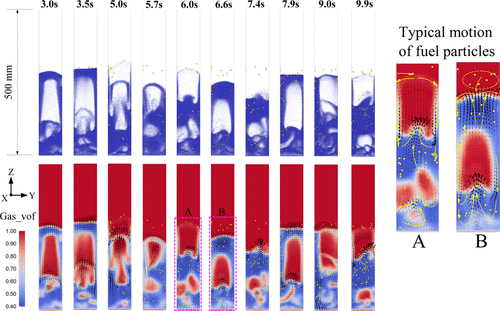当前位置:
X-MOL 学术
›
Ind. Eng. Chem. Res.
›
论文详情
Our official English website, www.x-mol.net, welcomes your feedback! (Note: you will need to create a separate account there.)
CFD–DEM Investigation of Fuel Dispersion Behaviors in a 3D Fluidized Bed
Industrial & Engineering Chemistry Research ( IF 4.2 ) Pub Date : 2021-09-02 , DOI: 10.1021/acs.iecr.1c02443 Guoqing Lian 1 , Wenqi Zhong 1 , Xuejiao Liu 1
Industrial & Engineering Chemistry Research ( IF 4.2 ) Pub Date : 2021-09-02 , DOI: 10.1021/acs.iecr.1c02443 Guoqing Lian 1 , Wenqi Zhong 1 , Xuejiao Liu 1
Affiliation

|
In this paper, dispersion behaviors of continuous-feeding fuel particles in a 3D fluidized bed were studied in detail using CFD–DEM simulations with a substantial difference in particle properties between the fuel and bed material, as well as the dynamic fuel-feeding process being reasonably considered. By quantitively evaluating the dispersion characteristics of fuel particles, the effects of key factors including the fluidization velocity, initial bed height, and the particle properties of fuel and bed materials on the dispersion behaviors of fuel particles were comprehensively examined with the motion and distribution of fuel particles being discussed in detail. The results indicated that crucially dominated by the bubble behaviors, the axial dispersion coefficient of fuel particles is 1–2 orders-of-magnitude larger than that in the radial direction in the fluidized bed. Increasing the fluidization velocity obviously promotes the dispersion and thus the uniformity distribution of the fuel particles. More intense axial dispersion of fuel particles appears with the higher initial bed height, under which conditions the axial distribution uniformity of fuel particles is efficiently improved. On the other hand, using the finer bed material enhances the fuel dispersion at the same fluidization velocity but instead weakens the dispersion at a similar fluidization number. Furthermore, the low-density fuel particles have a larger dispersion coefficient, which can be mainly explained by their preferential distribution behavior in the dense bed surface region.
中文翻译:

3D 流化床中燃料分散行为的 CFD-DEM 研究
在本文中,使用 CFD-DEM 模拟详细研究了连续进料燃料颗粒在 3D 流化床中的分散行为,燃料和床材料之间的颗粒特性存在显着差异,以及动态燃料进料过程合理考虑。通过定量评价燃料颗粒的分散特性,结合燃料的运动分布,综合考察流化速度、初始床层高度、燃料和床层材料的颗粒性质等关键因素对燃料颗粒分散行为的影响。粒子进行详细讨论。结果表明,在很大程度上受气泡行为的支配,在流化床中燃料颗粒的轴向扩散系数比径向扩散系数大1-2个数量级。提高流化速度明显促进了燃料颗粒的分散和均匀分布。初始床层高度越高,燃料颗粒轴向分散越强烈,在此条件下,燃料颗粒轴向分布均匀性得到有效提高。另一方面,使用更细的床材料在相同的流化速度下增强了燃料分散,但在相似的流化数下反而减弱了分散。此外,低密度燃料颗粒具有较大的分散系数,这主要可以通过它们在致密床表面区域的优先分布行为来解释。提高流化速度明显促进了燃料颗粒的分散和均匀分布。初始床层高度越高,燃料颗粒轴向分散越强烈,在此条件下,燃料颗粒轴向分布均匀性得到有效提高。另一方面,使用更细的床材料在相同的流化速度下增强了燃料分散,但在相似的流化数下反而减弱了分散。此外,低密度燃料颗粒具有较大的分散系数,这主要可以通过它们在致密床表面区域的优先分布行为来解释。提高流化速度明显促进了燃料颗粒的分散和均匀分布。初始床层高度越高,燃料颗粒轴向分散越强烈,在此条件下,燃料颗粒轴向分布均匀性得到有效提高。另一方面,使用更细的床材料在相同的流化速度下增强了燃料分散,但在相似的流化数下反而减弱了分散。此外,低密度燃料颗粒具有较大的分散系数,这主要可以通过它们在致密床表面区域的优先分布行为来解释。初始床层高度越高,燃料颗粒轴向分散越强烈,在此条件下,燃料颗粒轴向分布均匀性得到有效提高。另一方面,使用更细的床材料在相同的流化速度下增强了燃料分散,但在类似的流化数下减弱了分散。此外,低密度燃料颗粒具有较大的分散系数,这主要可以通过它们在致密床表面区域的优先分布行为来解释。初始床层高度越高,燃料颗粒轴向分散越强烈,在此条件下,燃料颗粒轴向分布均匀性得到有效提高。另一方面,使用更细的床材料在相同的流化速度下增强了燃料分散,但在相似的流化数下反而减弱了分散。此外,低密度燃料颗粒具有较大的分散系数,这主要可以通过它们在致密床表面区域的优先分布行为来解释。使用更细的床材料在相同的流化速度下增强了燃料分散,但在相似的流化数下减弱了分散。此外,低密度燃料颗粒具有较大的分散系数,这主要可以通过它们在致密床表面区域的优先分布行为来解释。使用更细的床材料在相同的流化速度下增强了燃料分散,但在相似的流化数下减弱了分散。此外,低密度燃料颗粒具有较大的分散系数,这主要可以通过它们在致密床表面区域的优先分布行为来解释。
更新日期:2021-09-15
中文翻译:

3D 流化床中燃料分散行为的 CFD-DEM 研究
在本文中,使用 CFD-DEM 模拟详细研究了连续进料燃料颗粒在 3D 流化床中的分散行为,燃料和床材料之间的颗粒特性存在显着差异,以及动态燃料进料过程合理考虑。通过定量评价燃料颗粒的分散特性,结合燃料的运动分布,综合考察流化速度、初始床层高度、燃料和床层材料的颗粒性质等关键因素对燃料颗粒分散行为的影响。粒子进行详细讨论。结果表明,在很大程度上受气泡行为的支配,在流化床中燃料颗粒的轴向扩散系数比径向扩散系数大1-2个数量级。提高流化速度明显促进了燃料颗粒的分散和均匀分布。初始床层高度越高,燃料颗粒轴向分散越强烈,在此条件下,燃料颗粒轴向分布均匀性得到有效提高。另一方面,使用更细的床材料在相同的流化速度下增强了燃料分散,但在相似的流化数下反而减弱了分散。此外,低密度燃料颗粒具有较大的分散系数,这主要可以通过它们在致密床表面区域的优先分布行为来解释。提高流化速度明显促进了燃料颗粒的分散和均匀分布。初始床层高度越高,燃料颗粒轴向分散越强烈,在此条件下,燃料颗粒轴向分布均匀性得到有效提高。另一方面,使用更细的床材料在相同的流化速度下增强了燃料分散,但在相似的流化数下反而减弱了分散。此外,低密度燃料颗粒具有较大的分散系数,这主要可以通过它们在致密床表面区域的优先分布行为来解释。提高流化速度明显促进了燃料颗粒的分散和均匀分布。初始床层高度越高,燃料颗粒轴向分散越强烈,在此条件下,燃料颗粒轴向分布均匀性得到有效提高。另一方面,使用更细的床材料在相同的流化速度下增强了燃料分散,但在相似的流化数下反而减弱了分散。此外,低密度燃料颗粒具有较大的分散系数,这主要可以通过它们在致密床表面区域的优先分布行为来解释。初始床层高度越高,燃料颗粒轴向分散越强烈,在此条件下,燃料颗粒轴向分布均匀性得到有效提高。另一方面,使用更细的床材料在相同的流化速度下增强了燃料分散,但在类似的流化数下减弱了分散。此外,低密度燃料颗粒具有较大的分散系数,这主要可以通过它们在致密床表面区域的优先分布行为来解释。初始床层高度越高,燃料颗粒轴向分散越强烈,在此条件下,燃料颗粒轴向分布均匀性得到有效提高。另一方面,使用更细的床材料在相同的流化速度下增强了燃料分散,但在相似的流化数下反而减弱了分散。此外,低密度燃料颗粒具有较大的分散系数,这主要可以通过它们在致密床表面区域的优先分布行为来解释。使用更细的床材料在相同的流化速度下增强了燃料分散,但在相似的流化数下减弱了分散。此外,低密度燃料颗粒具有较大的分散系数,这主要可以通过它们在致密床表面区域的优先分布行为来解释。使用更细的床材料在相同的流化速度下增强了燃料分散,但在相似的流化数下减弱了分散。此外,低密度燃料颗粒具有较大的分散系数,这主要可以通过它们在致密床表面区域的优先分布行为来解释。


























 京公网安备 11010802027423号
京公网安备 11010802027423号